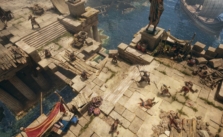Titan Quest 2’s Combat Systems Explained – Ailments, Supercrits & the Art of Pain
Titan Quest was so beautifully simple in its battle routine—you punch a mythical beast, it explodes in a rain of loot, you wash and rinse. Just the way it must be. But for the sequel, Grimlore Games is cranking up the tactical level to 11, introducing systems so deep they’ll have theorycrafters reaching for their spreadsheets in joy. Bye-bye mere bonking on the head of beasties. In Titan Quest 2 you’ll be an artist. And pain is your canvas.
A Recipe for Ruin: How Ailments Are Used
Getting your enemies miserable isn’t exactly a happy accident anymore. It’s a three-step holy ritual.
- The Audition. Every attack includes an Ailment-Chance—your vanilla roll to see if you even get to play the Ailment game. You can think of it as asking someone if you can hurt them. (spoiler: You don’t technically need their permission)
- The Flavor Profile. If you pass the check, the game decides what kind of damage you’re dealing—and this is where it’s brilliant. Are you bludgeoning a satyr with an enormous hammer that does 80% Strike Damage and 20% Fire thanks to a magical aura? Well, you have a great chance to Stagger him and a smaller one to Burn his furry legs. Your kinds of damage dictate your debuffs, allowing build identity to be something more than an act of defense against a bad fashion choice.
- The Complaint Department. Finally—the beast gets to fight back. A volcano in boots is, predictably, going to bulldoze your attempts to inflict Burning. This is where the target gets to say, “I’d like to decline your kind invitation to be electrocuted—thank you very much.”
Now for the fun part—if you chain your gear to get an Ailment-Chance over 100%, the game doesn’t just pat you on the back. No. That overage percentage is a chance to apply a second layer of an Ailment from the same attack. It’s the BOGO sale of debuffs. You’ll certainly want to take advantage of that offer; we’re already filling up our coupon binders… Because when it comes to the glorious, gory details of what Ailments actually do, they’re basically mythological Pringles: after you pop that first stack of Bleed onto a centaur, you can’t stop. One Ailment is a weakness indicator; any true hero stacks them up until the enemy is a quivering, sobbing mess of DoTs and slows, desperately hoping for the nirvana of a loot explosion.
The list of woe you’ll be meting out is as follows:
- Stagger (from Strike Damage): Turns that rampaging minotaur into a behemoth-sized tot on roller skates. Slows movement and attack speed.
- Bleeding (from Pierce Damage): For when you want to drive home your point. A very, very pointed tip.
- Burning (from Fire Damage): The “set it and forget it” DoT classic. For the pyromaniac within us all.
- Chilled (from Cold Damage): The party pooper supreme : a DoT & a slow, because kicking them while they’re down is just efficient.
- Plagued (from Poison Damage): Turns your foe’s internal organs into a highly corrosive soup. Don’t even bother inquiring about the recipe…
- Shocked (from Lightning Damage): The most disruptive of the lot—with an existing DoT on top of it, it can freeze abilities, putting their deadliest spell into hysterics as it hiccups and sputters out completely.
The icing on the cake? All Ailment damage is True Damage. The kind that ignores your armor, going right past it. The perfect tool for cracking open the most recalcitrant nuts.
Supercrits: When Regular Crits Just Aren’t Critical Enough
It wouldn’t be an ARPG without big, pretty, yellow numbers—and Critical Strikes are back, spreading more harm and—you guessed it—being more likely to apply all those nice Ailments. So what happens if you—a diligent student of savagery—overload your Crit Chance over 100%? You receive Supercrits. Godlike, screen-thudding attacks. More harm… an increased Ailment probability. This is the reward for pathological stat-stacking—and we can hardly wait to see the damage numbers that force the game’s calculator to weep.
How to Not Die
Of course, the annoying citizens of this world will be trying to implement these very same systems on you. Luckily for you ; you’re not made of paper. Listed below are the layers of defense between you and a dirt nap, checked in this order:
- Glancing: That lucky moment when an impact that would have erased your health bar becomes a stiff jab. A mere flesh wound.
- Protection & Damage Reduction: The bubble wrap. Effects of your legendary “damage-eating pants” or something similar activate right here.
- Resistances: Your elemental armor—keeping a fireball from becoming a really nasty sunburn.
- Armor: Your defense against anything blunt or sharp. The reason you can take a sword to the chest and merely grumble.
- Shielding Effects: The panic button. Your safety net… Absorbs whatever’s left over before it reaches your valuable health…
This multi-level system promises a rich survival puzzle. Between Supercrit building and Ailment cocktail design, we envision our next spreadsheets having more tabs than an ancient Greek library. And honestly?? We couldn’t be more thrilled…
New ARPG Titan Quest 2 Coming Soon — Grimlore Games Reveals Exciting Details





![Titan Quest 2 Boss Guide: Complete Early Access Roster [2025] 29](https://www.magicgameworld.com/wp-content/uploads/2025/08/29-223x137.jpg)

